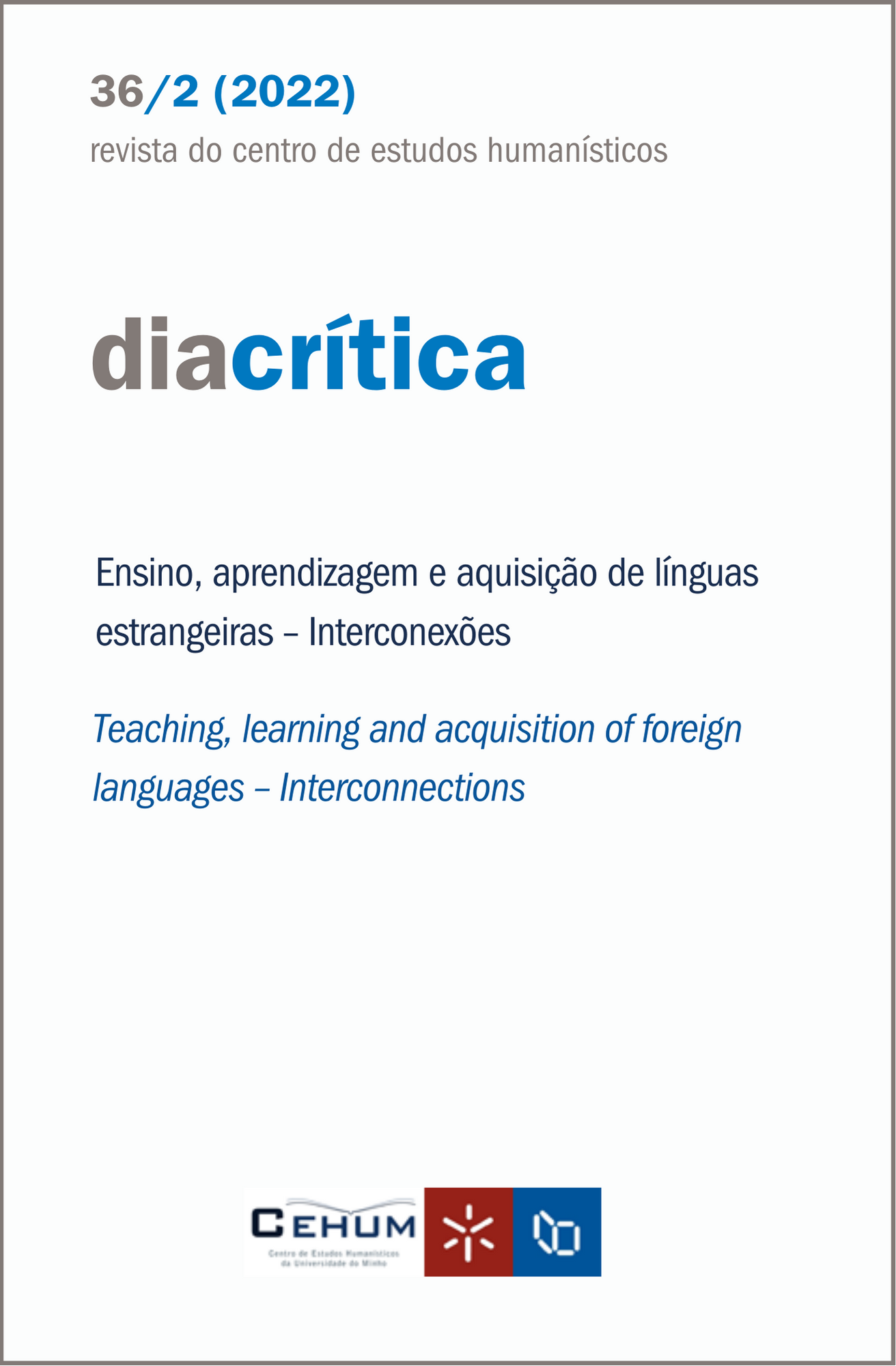Technology empowers: an investigation of ICALL’s influence on the design of self-regulated learning materials
DOI:
https://doi.org/10.21814/diacritica.4816Keywords:
ICALL, Self-regulated learning materials, PFLAbstract
Technology has generated convergence in language teaching, improving classroom teaching and creating new possibilities for autonomous learning. Intelligent Computer-Assisted Language Learning (ICALL) allows to correct errors autonomously and intelligently, based on the Intelligent Tutorial System (ITS) and to develop learning and autonomy strategies. The self-regulated learning materials associated with ICALL have enriched learning methods and have given learners more possibilities to learn outside the classroom, helping them develop autonomous learning. This study aims to analyse the influence of ICALL on the design of Portuguese as Foreign Language (PFL) self-regulated learning materials, investigating how technology allows learners to understand why they study, what they study and how they study. It demonstrates what ICALL does best in identifying and correcting errors, but also concludes that its models and structures still need to be improved compared to printed self-regulated learning materials. The aim is thus to promote the articulation between foreign language learning, the learning of PFL and the dynamics of societies increasingly marked by the use of technologies.
References
Benson, P. (2001). Teaching and researching autonomy in language learning. Person Education.
Breen, M. P. (1987). Learner contributions to task design. In C.N. Candlin & D. Murphy (Eds.), Language Learning Tasks (pp. 23–46). Prentice-Hall International.
Cai, H. J. (2004). The Theoretical Study on the Development of Self-instructional Materials in Ordinary University [Master dissertation, Fujian Normal University]. CNKI.
Chanier, T. (1994). Special issue on language learning: introduction. Journal of Artificial Intelligence in Education, 5(4), 417–427.
Conselho da Europa. (2001) Quadro Europeu Comum de Referência para as Línguas: aprendizagem, ensino, avaliação. Edições ASA.
Council of Europe. (2020). Common European framework of reference for languages: learning, teaching, assessment – companion volume. Council of Europe Publishing.
Du, L., Lin, Z., & Yin, B. (2010). The application of AI technology in intelligent tutoring system. In 2010 2nd International Conference on Education Technology and Computer (ICETC) (Vol. 1, pp. 490–493). Institute of Electrical and Electronic Engineers DOI: https://doi.org/10.1109/ICETC.2010.5529201
Ellis, R. (2006). The methodology of task-based teaching. Asian EFL Journal, 8(3), 19–45.
Garrett, N. (1995). ICALL and second language acquisition. In V. Melissa Holland, Jonathan D. Kaplan & Michelle R. Sams (Eds.), Intelligent language tutors: theory shaping technology (pp. 363–376). Routledge.
Holec, H. (1981) Autonomy and foreign language learning. Pergamon Press.
Jewitt, C. (2009). An introduction to multimodality. In C. Jewitt (Ed.), The Routledge handbook of multimodal analysis (pp. 14–27). Routledge.
Kessler, G. (2009). Student-initiated attention to form in Wiki-based collaborative writing. Language learning & Tecnology, 13(1), 79–95.
Lennon, P. (1991). Error: some problems of definition, identification, and distinction. Applied Linguistics, 12(2), 180–196. https://doi.org/10.1093/applin/12.2.180 DOI: https://doi.org/10.1093/applin/12.2.180
Levy, M. (1997). Computer assisted language learning: context and conceptualization. Oxford University.
Little, D. (1991). Learner autonomy: definitions, issues and problems. Authentik Language Learning Resources Ltd.
Littlewood, W. (1996). “Autonomy”: an anatomy and a framework. System, 24(4), 427–435. https://doi.org/10.1016/S0346-251X(96)00039-5 DOI: https://doi.org/10.1016/S0346-251X(96)00039-5
Long, M. H. (1985). A role for instruction in second language acquisition: task-based language teaching. In K. Hyltenstam & M. Pienemann (Eds.), Modelling and assessing second language acquisition (Vol. 18, pp. 77–100). Multilingual Matters.
Martin, A., & Ashworth, S. (2004). Welcome to the Journal of eLiteracy!. Journal of eLiteracy, 1(1), 2–6.
Nunan, D. (1997). Designing and adapting materials to encourage learner autonomy. In P. Benson & P. Voller (Eds.), Autonomy and independence in language learning (pp. 192–203). Addison Wesley Longman. DOI: https://doi.org/10.4324/9781315842172-16
Pang, W.G. (2003). Self-regulated learning: principles and educational applications. East China Normal University Press.
Postlethwait, S. N. (1970). The audio-tutorial system. The American Biology Teacher, 32(1), 31–33. https://online.ucpress.edu/abt/article/32/1/31/8390/The-Audio-Tutorial-System DOI: https://doi.org/10.2307/4442884
Ren, D. B. (2009). The essence and features of college self-study teaching material. Economic Research Guide, 25, 258–260.
Rowntree, D. (1990). Teaching through self-instruction: how to develop open learning materials. Kogan Page.
Yu, X. (2021). O desenho dos materiais digitais de aprendizagem autorregulada: no ensino de PLE em nível básico. Portuguese Language Journal, 15, 68–82. https://www.portugueselanguagejournal.com/files/ugd/02e26d_b0677079f4534744b9e4af48edcc1a89.pdf
Yu, X. (2019). Uma investigação para o desenho de materiais de aprendizagem autorregulada de PLE em nível básico no âmbito de ICALL [Dissertação de Mestrado, Universidade de Lisboa]. Repositório da Universidade de Lisboa. https://repositorio.ul.pt/handle/10451/ 40820
Zimmerman, B. (1989). A social cognitive view of self-regulated academic learning, Journal of Educational Psychology, 81(3), 329–339. https://doi.org/10.1037/0022-0663.81.3.329 DOI: https://doi.org/10.1037/0022-0663.81.3.329
Zimmerman, B. J. (1995). Self-efficacy and educational development. In A. Bandura (Ed.), Self-efficacy in changing societies (pp. 202–231). Cambridge University Press. DOI: https://doi.org/10.1017/CBO9780511527692.009
Zimmerman, B.J., & Pons, M. M. (1986). Development of a structured interview of assessing student use of self-regulated learning strategies. American Educational Research Journal, 23(4), 614–628. https://doi.org/10.3102/00028312023004614 DOI: https://doi.org/10.3102/00028312023004614
Downloads
Published
How to Cite
Issue
Section
License
Copyright (c) 2023 Xuechun Yu, Catarina Gaspar

This work is licensed under a Creative Commons Attribution-NonCommercial 4.0 International License.










